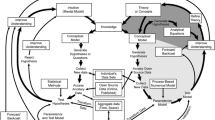Abstract
Increasingly ecologists are asked to contribute to decision-making processes in resource management and development by giving their assessment of the impact of natural and artificial environmental changes. In many cases time or resource constraints make detailed ecological studies impossible and so ecologists must make educated guesses based on available data. The accuracy of these assessments can be improved by making data more accessible to ecologists, and increasing their ability to analyse data rapidly and efficiently. User-friendly database systems are hence a vital ecological tool.
Access this chapter
Tax calculation will be finalised at checkout
Purchases are for personal use only
Preview
Unable to display preview. Download preview PDF.
Similar content being viewed by others
Bibliography
Abel, D.E. Application of a formal specification language to animal ecology. Ecological Modelling, 50, 205–212, 1990.
Boguraev, B.K., Copestake, A.A. and Sparck Jones, K. Inference in Natural Language Front Ends. in Data and Knowledge, (R.A. Meersman and A.C. Sernadas eds.) North Holland/Elsevier Science Publications 1988.
Bratko, I. Prolog Programming for Artificial Intelligence. Second Edition. Addison-Wesley, 1989
Bundy, A. Intelligent Front Ends. In J. Fox, ed. State of the Art Report on Expert Systems, pp15–24. Pergamon Infotech, 1984. Also in proceedings of British Computer Society Specialist Group on Expert Systems 1984.
Catterall, C.P. Winter energy deficits and the importaance of fruit versus insects in a tropical island bird population. Australian Journal of Ecology (1985) 10, 265–279.
Catterall, C.P. The Economics of Winter Fighting in Silvereyes. Emu 89, 173–176.
Catterall, C.P., Kikkawa, J. and Gray, C. Inter-related age-dependent patterns of ecology and behaviour in a population of Silvereyes. Journal of Animal Ecology (1989) 58, 557–570.
Checkland, P. Soft Systems Methodology. In Rational Analysis for a Problematic World (J. Rosenhead ed.), chapters 4 & 5. John Wiley and Sons Ltd, 1989.
Davies, L.J. and Ledington, P.W.J. Creativity and Metaphor in Soft Systems Methodology. Journal of Applied Systems Analysis (1988) 15.
Debenham, J. Knowledge Systems Design. Prentice Hall 1989.
Haggith, M. Artificial Intelligence Tools for Ecologists in Proceedings of the Workshops of the AI 90 Conference, Perth, November 1990.
Huberman, B.A. ed. The Ecology of Computation North Holland/Elsevier Scientific Publications, 1988.
Marcus, C. Prolog Programming. Addison-Wesley 1986.
Minsky, M. A framework for representing knowledge. In Mind Design (John Haugeland ed.) pp 95–128, MIT Press, 1981.
Muetzelfeldt, R., Robertson, D., Bundy, A. and Uschold, M. The Use of Prolog for improving the rigour and accessibility of ecological modelling. Ecological Modelling, 1988.
Niven, B.S. Formalisation of the basic concepts of animal ecology. Erktennis, 17, 307–320, 1982.
Pereira, F.C.N. & Shieber, S.M. Prolog and Natural Language Analysis. CSLI Lecture Notes, Chicago University Press, Stanford, 1987.
Pilote, M. Modelling Linguistic User Interfaces. in Proc. First International Conference on Expert Database Systems. (L. Kerschberg, ed.) Charleston 1986.
Robertson, D., Bundy, A., Muetzelfeldt, R., Haggith, M., Uschold, M. Eco-Logic: Logical Perspectives on Ecological Modelling. MIT Press 1991.
Author information
Authors and Affiliations
Editor information
Editors and Affiliations
Rights and permissions
Copyright information
© 1991 Springer-Verlag Berlin Heidelberg
About this paper
Cite this paper
Haggith, M., Sterwart-Zerba, L., Douglas, P. (1991). BIRDZ: Making Ecological Data Digestible. In: Hälker, M., Jaeschke, A. (eds) Informatik für den Umweltschutz / Computer Science for Environmental Protection. Informatik-Fachberichte, vol 296. Springer, Berlin, Heidelberg. https://doi.org/10.1007/978-3-642-77164-4_21
Download citation
DOI: https://doi.org/10.1007/978-3-642-77164-4_21
Publisher Name: Springer, Berlin, Heidelberg
Print ISBN: 978-3-540-54932-1
Online ISBN: 978-3-642-77164-4
eBook Packages: Springer Book Archive




